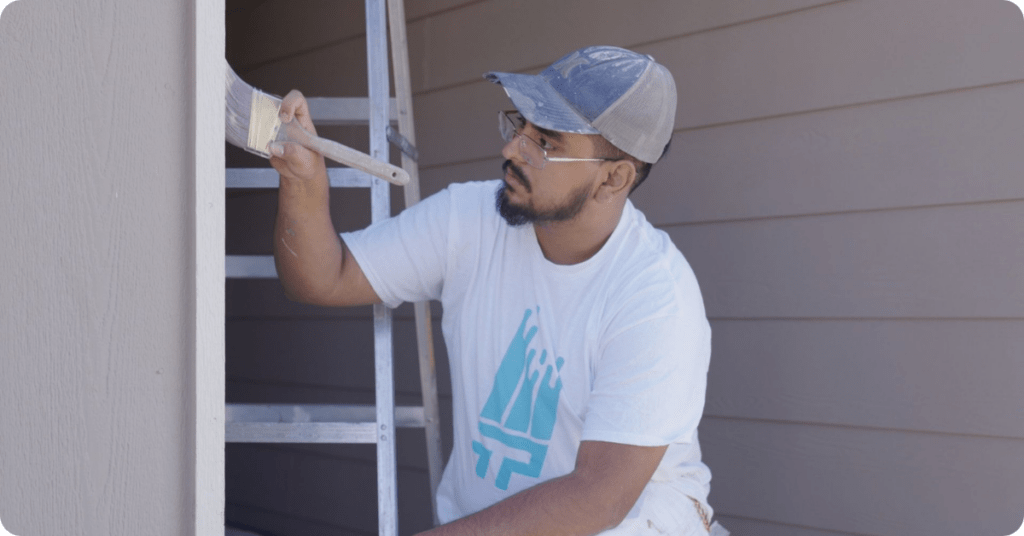What to Know About Painting During High Humidity in Fort Bend County
Painting in High Humidity? Here’s What You Need to Know!
Humidity and painting don’t always mix. If you’ve ever tried painting in high humidity—whether it’s a room or the exterior of your home on a muggy day in Fort Bend County—you may have noticed some unexpected challenges: sticky paint, slow drying times, and even bubbling or peeling. It’s frustrating! But that doesn’t mean you can’t get a smooth, professional finish. You just need to know how to work with the climate, not against it.
That 1 Painter Fort Bend County has years of experience painting in Texas’ unpredictable weather, and we know exactly how to achieve flawless results—even when the air is thick with moisture. Whether you’re tackling an interior refresh or an exterior makeover, let’s dive into the best ways to paint successfully in high humidity.
How Humidity Affects Paint and Drying Times
Humidity isn’t just an inconvenience—it can make or break your paint job. When the air is saturated with moisture, paint takes longer to dry, increasing the risk of imperfections.
Slower drying times: Excess moisture in the air prevents water-based paints from evaporating properly, leaving your walls feeling tacky for much longer.
Adhesion problems: High humidity can weaken the bond between paint and surface, leading to peeling or bubbling.
Uneven finish: Excess moisture can cause streaking or an inconsistent texture, especially with exterior painting.
Mold and mildew growth: Damp conditions can create the perfect environment for mold and mildew to form under or on top of the paint.

Best Conditions for Painting in Fort Bend County
The ideal humidity level for painting is between 40-50%.
If outdoor humidity is above 70%, wait for a drier day or start early in the morning when moisture levels are lower.
Use a hygrometer to check indoor humidity before starting an interior project.
Choosing the Right Paint and Materials for Humid Weather
Not all paints are created equal—especially when humidity is involved. To ensure long-lasting results, choose high-quality products that can withstand moisture.
Best Paint Types for High-Humidity Conditions
Acrylic latex paint: This is the best option for humid climates because it dries faster and is more resistant to moisture than oil-based paints.
Mold-resistant paints: These contain additives that help prevent mildew growth, making them ideal for bathrooms, kitchens, and humid exterior conditions.
High-quality primers: A good primer can help seal the surface and improve paint adhesion, reducing the risk of peeling.
Essential Tools for a Smooth Finish
Synthetic brushes and rollers: They hold less moisture than natural fiber brushes, making them ideal for humid weather.
Dehumidifiers and fans: If painting indoors, these tools can help speed up drying time.
Exterior sealers: For outdoor projects, a protective sealer will help safeguard your paint job from Texas’ unpredictable humidity.
Preparing Surfaces for Painting in High Humidity
A perfect paint job starts with proper preparation. If you’re working in humid conditions, extra steps are needed to ensure the surface is ready for paint.
How to Prep Your Walls for Success
Check for moisture: Use a moisture meter to test the walls before painting. If levels are too high, wait for drier conditions.
Thoroughly clean the surface: Dirt and grease can trap moisture, leading to adhesion issues. Wash walls with a mild detergent and let them dry completely.
Use a high-quality primer: This creates a barrier between the surface and the paint, preventing moisture from seeping through.
Sand glossy surfaces: If painting over a previously painted wall, lightly sand to improve adhesion.
Pro Tips for Painting Successfully in High Humidity
Even if the humidity is high, you can still achieve professional-quality results with these expert techniques:
Paint early or late in the day: Avoid peak humidity hours (midday to late afternoon). Early mornings and evenings tend to be drier.
Increase air circulation: Open windows, turn on fans, and use dehumidifiers when painting indoors.
Apply thin coats: Thicker layers trap moisture and take longer to dry. Multiple thin coats will dry faster and more evenly.
Use a paint extender: Adding a paint conditioner or extender can improve flow and reduce brush marks, especially in humid conditions.
Troubleshooting Common Painting Issues in High Humidity
Humidity can throw some frustrating obstacles your way, but knowing how to fix them will save you time and effort.
Dealing with Paint Blistering and Bubbling
What causes it? Moisture gets trapped between the paint and the surface.
How to prevent it? Always prime surfaces and paint in low-humidity conditions.
Fixing the problem: Scrape off the bubbles, sand the area, and repaint with a quality primer and moisture-resistant paint.
Addressing Slow Drying Times
Turn on dehumidifiers and fans to speed up evaporation.
Use fast-drying paint formulas designed for humid conditions.
Avoid thick layers—opt for multiple thin coats instead.
Preventing Mold and Mildew Growth
Choose mold-resistant paints for high-humidity rooms like bathrooms and kitchens.
Keep air flowing during and after painting to discourage moisture buildup.
Clean surfaces regularly to prevent mold from forming over time.
Achieve a Flawless Finish with That 1 Painter Fort Bend County
Painting in high humidity doesn’t have to be a struggle! With the right paint, tools, and techniques, you can achieve a smooth, long-lasting finish—even in Fort Bend County’s unpredictable climate.
But why take on the hassle alone? At That 1 Painter Fort Bend County, we know how to work with Texas’ humidity to deliver flawless results every time. Our team uses top-quality, moisture-resistant paints and professional techniques to ensure your home looks its best, no matter the weather. Whether it’s an interior refresh or an exterior makeover, we’re here to help.
Call us today and let’s bring your vision to life!